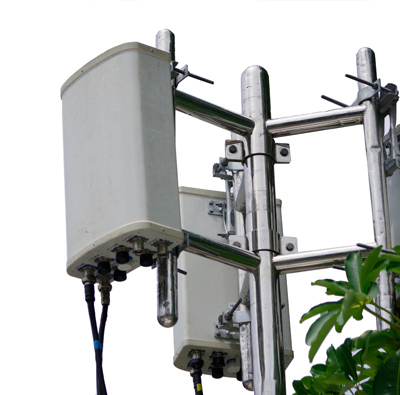Commercial adoption of 5G wireless communication technology is driving new infrastructure designs for the projected increase in the number of base stations. These units operate at wide frequency ranges and are situated closer together to provide optimal connectivity. Key trends affecting these designs include the increasing complexity of centralized base stations, many of which will incorporate beamforming massive multiple-input, multiple-output (MIMO) antennas that use not only the low-frequency Sub-6 GHz band, but also the high-frequency millimeter wave spectrum.
Another factor is the need for new printed circuit board (PCB) designs that can handle broad 5G frequencies while minimizing signal loss. Ultimately, as 5G adoption accelerates, the industry will need new solutions that help reduce the time, effort and risk involved in installing base stations.
Benefits of Specialty Polymers for 5G
As engineers create new designs for 5G base station antennas, circuit boards and other system components, they are utilizing new high-performance specialty polymers that can achieve stable RF quality, low system cost and high productivity for these components. These materials include high-temperature thermoplastics such as polyphenylene sulfide (PPS), liquid crystal polymers (LCPs) and fluoropolymers.
In addition to excellent, stable dielectric properties that become more critical at 5G’s high-frequency bands, these polymers offer performance advantages such as thermal and dimensional stability, chemical resistance, inherent flame retardance (FR) and RF transparency. They also deliver the design and processing benefits typically associated with specialty plastics:
- Greater freedom to design complex shapes, incorporate thin-wall geometries and consolidate parts
- Lower weight vs. metal for easier handling and installation
- Ability to boost productivity and drive down system costs through high-speed, high-volume injection molding
Polyphenylene Sulfide (PPS) Replaces Metal
 For base stations, Solvay’s Ryton® PPS resin can enable part integration between the antenna substrate (PCB) and oscillator, dipole, filter, duplexer and other components to simplify design and production. For example, a selectively plated Ryton® part may integrate the PCB, oscillator and the holders or fasteners. This part consolidation avoids the need for, and cost associated with, assembling separate components into the application. For further simplicity, a fully metallized Ryton® PPS part can replace the metal filters (see image).
For base stations, Solvay’s Ryton® PPS resin can enable part integration between the antenna substrate (PCB) and oscillator, dipole, filter, duplexer and other components to simplify design and production. For example, a selectively plated Ryton® part may integrate the PCB, oscillator and the holders or fasteners. This part consolidation avoids the need for, and cost associated with, assembling separate components into the application. For further simplicity, a fully metallized Ryton® PPS part can replace the metal filters (see image).
 Metallized Ryton® PPS resin can replace metals such as aluminum to ensure reliable signal transmission with very little loss of signal power, while reducing infrastructure weight to facilitate easier base station installation. This material features a very low coefficient of linear thermal expansion (CLTE) to minimize stress during metallization and optimize signal stability. An ultra-low CLTE across a wide range of operating temperatures is also important for reliable RF transmissions over time (see image).
Metallized Ryton® PPS resin can replace metals such as aluminum to ensure reliable signal transmission with very little loss of signal power, while reducing infrastructure weight to facilitate easier base station installation. This material features a very low coefficient of linear thermal expansion (CLTE) to minimize stress during metallization and optimize signal stability. An ultra-low CLTE across a wide range of operating temperatures is also important for reliable RF transmissions over time (see image).
The semi-crystalline PPS polymer offers exceptional dimensional stability for precision-molded components exposed to prolonged, high-temperature service conditions. It also provides excellent resistance to harsh chemicals and inherent flame retardance without the need for additives.
Solvay’s Xydar® LCP is a reinforced resin that features excellent flow properties. It can be injection molded to create thin-wall components and provides outstanding strength at extreme temperatures up to 300°C (572 °F). Xydar® LCP resin is inherently flame retardant, transparent to microwave signals and resistant to virtually all chemicals. Compared to PPS, Xydar® LCP provides improved dielectric performance for future high-frequency radio component design.
 Select grades of Ryton® PPS and Xydar® LCP were specifically developed to address the requirements of low loss tangents and high dimensional stability at long-term, high working temperatures. Both are compatible with existing industrial metallization processes. These materials are formulated to deliver stable dielectric performance, including dissipation factor (Df) and dielectric constant (Dk) properties, while maintaining a high level of dimensional stability and flowability (see image).
Select grades of Ryton® PPS and Xydar® LCP were specifically developed to address the requirements of low loss tangents and high dimensional stability at long-term, high working temperatures. Both are compatible with existing industrial metallization processes. These materials are formulated to deliver stable dielectric performance, including dissipation factor (Df) and dielectric constant (Dk) properties, while maintaining a high level of dimensional stability and flowability (see image).
Conclusion
While the public spotlight is on 5G’s promised high speeds, behind the scenes are many practical considerations for delivering on this next generation of wireless networking. One key enabler will be the thousands of base stations needed to optimize connectivity. Efficiently deploying these stations depends in large part on advanced materials that can streamline design, manufacturing and installation, while providing consistent performance in challenging environments. High-performance thermoplastics offer important advantages over traditional metal and commodity resins and are expected to play a key role in the successful transition to 5G technology.
